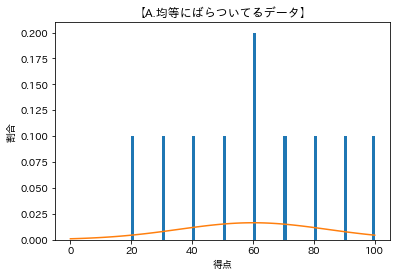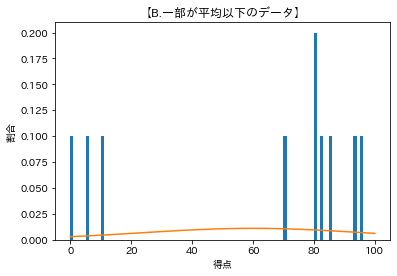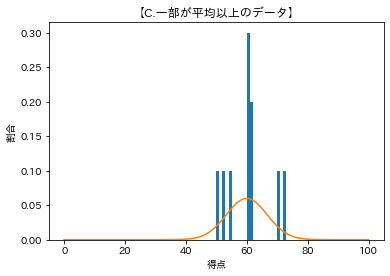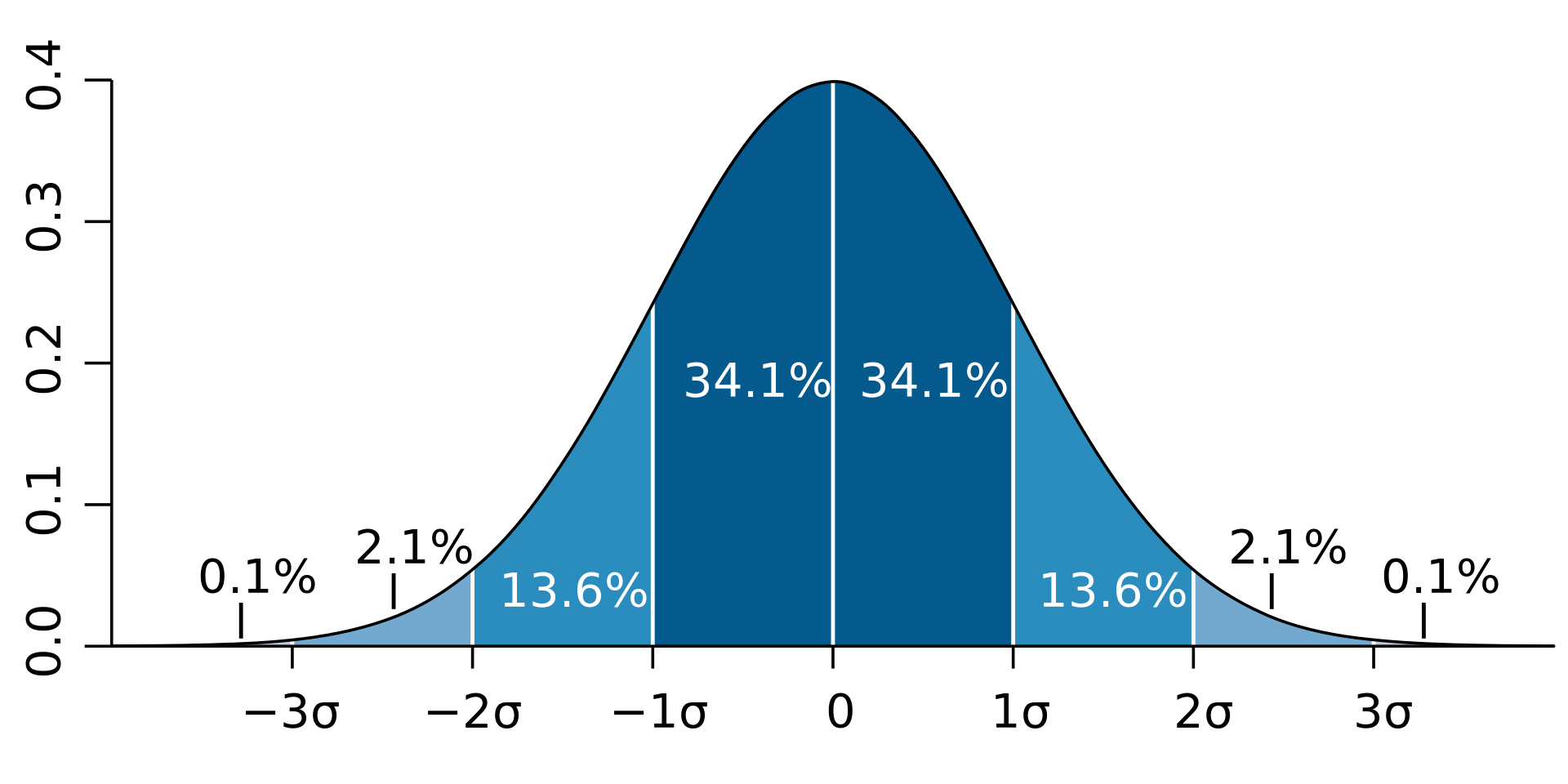標準偏差とは
https://ja.wikipedia.org/wiki/標準偏差
標準偏差(ひょうじゅんへんさ、(英: standard deviation, SD)とは、データや確率変数の、平均値からの散らばり具合(ばらつき)を表す指標の一つである。偏差ベクトルと、値が標準偏差のみであるベクトルは、ユークリッドノルムが等しくなる。
標準偏差を2乗したのが分散であり、従って、標準偏差は分散の非負の平方根である[1]。標準偏差が 0 であることは、データの値が全て等しいことと同値である。
母集団や確率変数の標準偏差を σ で、標本の標準偏差を s で表すことがある。
二乗平均平方根 (RMS) を用いると、標準偏差は偏差の二乗平均平方根に等しくなる。
なるほどわからん。
どうやら平均からどれだけデータがばらついているかを表す指標ということらしい。
平均は文系の私でもまあわかる。
標準偏差は次の式で求められるみたいだが…。
…まあこれは置いといてnumpyのstd()で求められるので試してみる。
import numpy
scores = [
{
"label": "【A.均等にばらついてるデータ】",
"data": [
20, 30, 40, 50, 60,
60, 70, 80, 90, 100,
],
},
{
"label": "【B.一部が平均以下のデータ】",
"data": [
0, 5, 10, 70, 80,
80, 82, 85, 93, 95,
],
},
{
"label": "【C.一部が平均以上のデータ】",
"data": [
50, 52, 54, 60, 60,
60, 61, 61, 70, 72,
],
},
]
def print_mean_and_std(label, data):
print(label)
mean = numpy.average(data)
print("平均:%s" % mean)
std = numpy.std(data)
print("標準偏差:%s" % std)
for score in scores:
print_mean_and_std(score["label"], score["data"])
【A.均等にばらついてるデータ】
平均:60.0
標準偏差:24.49489742783178
【B.一部が平均以下のデータ】
平均:60.0
標準偏差:36.67151483099655
【C.一部が平均以上のデータ】
平均:60.0
標準偏差:6.6783231428256
で、この標準偏差で出てきた数値がなんなんだってばよ…。
調べると標準偏差が求まることで、平均±標準偏差の範囲にデータの分布が集中していることがわかるそう。
つまり上記の例のCならば60.0±6.6783231428256なので52.3~66.6の間に分布が集中していることになると。
うん、確かに。
正規分布
これをわかりやすくするために正規分布というグラフにしてみる。
# !pip install japanize-matplotlib
import matplotlib.pyplot as plt
import japanize_matplotlib
import numpy
from scipy.stats import norm
scores = [
{
"label": "【A.均等にばらついてるデータ】",
"data": [
20, 30, 40, 50, 60,
60, 70, 80, 90, 100,
],
},
{
"label": "【B.一部が平均以下のデータ】",
"data": [
0, 5, 10, 70, 80,
80, 82, 85, 93, 95,
],
},
{
"label": "【C.一部が平均以上のデータ】",
"data": [
50, 52, 54, 60, 60,
60, 61, 61, 70, 72,
],
},
]
def plot_hist(label, data):
mean = numpy.average(data)
std = numpy.std(data)
fig, ax = plt.subplots()
ax.set_title(label)
ax.set_xlabel("得点")
ax.set_ylabel("割合")
bins = numpy.arange(0, 101)
plt.hist(data, bins, density=True)
xn = numpy.linspace(min(bins), max(bins), 100)
yn = norm.pdf(xn, loc=mean, scale=std)
plt.plot(xn, yn)
plt.show()
for score in scores:
plot_hist(score["label"], score["data"])
カーブのてっぺんが平均値の位置で、標準偏差が大きいほどばらついてるのでカーブの幅が広くなっている。
1σ、2σ、3σ
標準偏差×1したものを1σ。
×2したものを2σ、×3したものを3σと呼ぶそう。
で、それぞれの区間に分布が収まる確率が
- 1σ = 約68%
- 2σ = 約95%
- 3σ = 約99.7%
となり、この法則は平均や標準偏差の値が何であれ成り立つそう。
68–95–99.7則とも呼ばれる。
まとめ
標準偏差を理解するために書いてみました。
数式だととっつきづらいけど、Notebookにコードを書きながら学んでみると何となく理解できるもんですね。
参考




